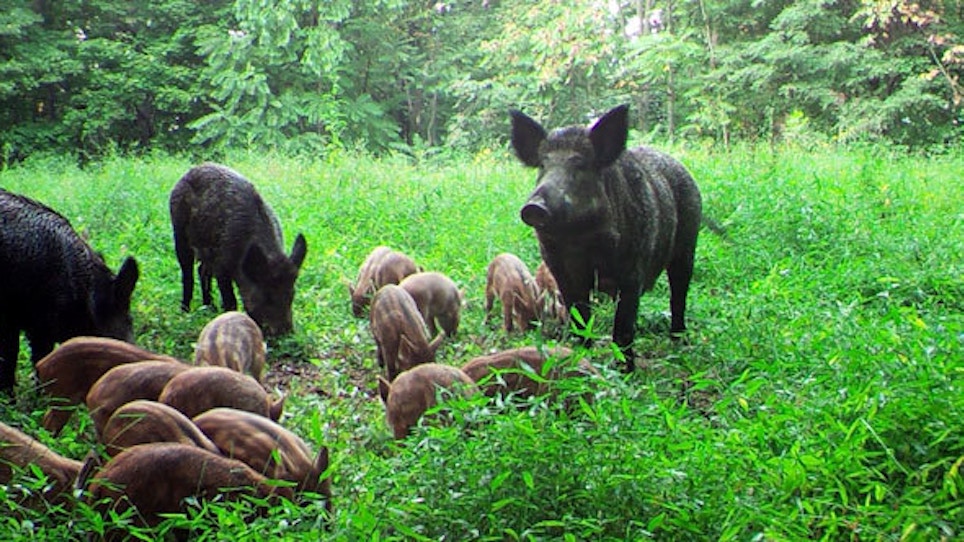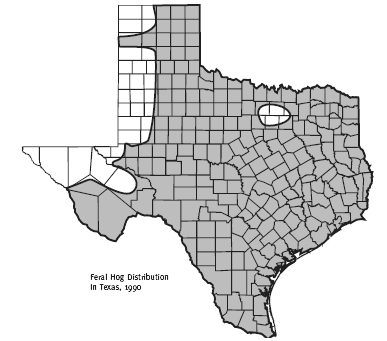
Some believe Texas may be home to more than half of the country's feral pigs. With so much open land and habitat, that may be correct. (Photo: USDA)
PolitiFact, a fact-checking site mostly known for holding politicians accountable for misleading statements on matters of policy and things like pork barrel spending, recently shifted its attention to a truth-seeking mission involving actual pork.
Specifically, PolitiFact took issue with an article posted by Southwest FarmPress claiming Texas was home to an “estimated 50 percent to 75 percent of all feral swine in the nation.”
PolitiFact wasn’t buying it: “Really all of that for Texas by its lonesome? We wondered.”
If this kind of stuff interest you – and for many predator hunters knowing as much as possible about the critters they hunt is time well spent — PolitiFact's digging ends up also offering a concise snapshot into feral pig populations, both in Texas and nationally.
South Carolina hog expert Jack Mayer, Ph. D confirmed in a 2014 research paper that Texas was in fact home to the most wild hogs.
“According to the paper, 99 percent of U.S. wild pigs live in 10 states: Alabama, Arkansas, California, Florida, Georgia, Louisiana, Mississippi, Oklahoma, South Carolina and Texas. ‘As an individual state, Texas had the largest numbers,’ the paper says, accounting for 30 percent (1.8 million) up to 41 percent (3.4 million) of the nation’s total depending on which estimates are chosen. States with the next-most feral hogs, the paper suggests, were Georgia and Florida.”
But if you consider which state has the most wild hogs per capita, based on Mayer's data, Texas is actually fifth among all states with a little under 10 hogs per 100 residents. Oklahoma led with nearly 13 hogs per 100 residents.
Sorry, Oklahoma. It appears that, by this metric, you’re the “winner.”
Meanwhile, a September 2017 Q&A with Texas A&M professor emeritus Billy Higginbotham offered these answers:
"'(In Texas) we estimate 2.6 million head based on several population studies.' Another Higginbotham answer says a Texas A&M AgriLife Extension survey of landowners made in 2010 'estimated that we are removing approximately 761,000 pigs from our 2.6 million population annually, which accounts for only 29 percent of the population. We estimate that in Texas we need to be removing 66 percent of the wild pigs annually just to hold the population steady.'"
When asked by PolitiFact about the Texas wild hog population related to the state's share of the overall national population, Higginbotham answered that feral hogs in Texas probably comprise 20 percent to no more than 33 percent of the U.S. population.
If you're wondering how America ended up with so many wild boars, a Grand View Outdoors post, “It’s never boaring, hogs are everywhere,” offers some historical context:
On bowhunting boars, Grand View Outdoors contributor Bob Robb said, "Wild hogs are also one of the toughest critters in North America. You have to hit them properly, through both lungs or the heart, or they will lead you on a long and often fruitless chase."
"Technically, the wild hogs we hunted then, as today, are not wild boar in a purely biological sense, nor are they North American natives. In fact, the first wild pigs in the United States originated solely from domestic stock brought to North America by early European explorers and settlers. Domestic hogs were first introduced in the 1500s to Florida by Spanish explorer Hernando deSoto as he searched for the mythical fountain of youth. In later years in California, the Spanish, moving north from Mexico, herded them along as a food source. In the centuries that followed, free-range livestock management practices and escapes from enclosures resulted in the establishment of wild domestic pig populations and promoted their spread.
It was not until 1912 that true Russian wild boar were introduced, first at Hooper Bald, North Carolina, from where they soon were exported to other areas in Tennessee, Mississippi, Georgia, Florida, Louisiana, South Carolina, West Virginia and even New Hampshire. Some were also transported to the massive Hearst Ranch in Monterrey County, California. Though these early transplants were done in a controlled manner as people tried to keep them contained in large fenced 'game-proof' areas (primarily so they could hunt them), many escaped. In areas where these true wild boar met up with strains of domestic hogs living a free-range lifestyle they interbred, giving us the hybrid feral swine we have in America today."
Related: My first hog hunt
Related: Just how deadly is a wild boar?
Related: Night hog hunting with suppressed shotguns
Related: Hog Apocalypse: Is Poisoning Hogs The Way To Go In Texas?






